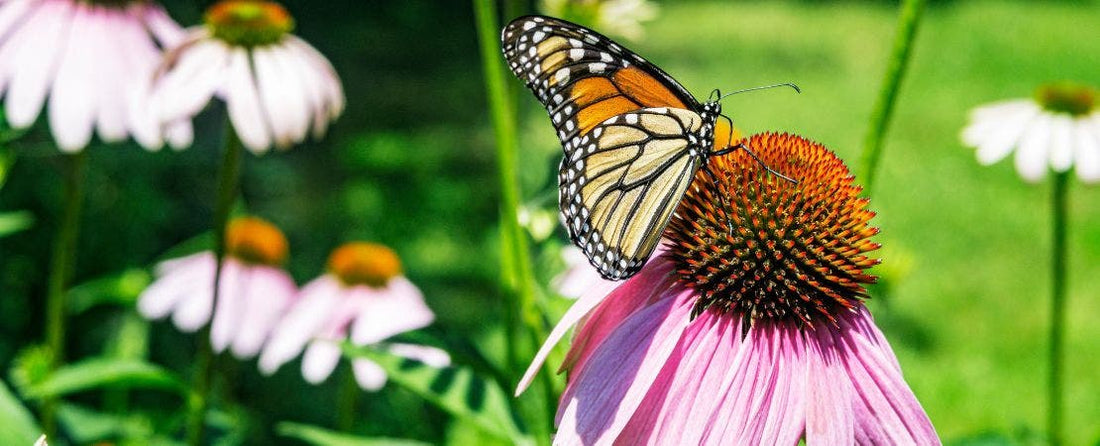Native Beauties! And More Reasons to Grow Echinacea

Benefits and Inspiration for Growing Echinacea
Echinacea, also known as coneflower, has gained immense popularity among gardeners for its vibrant blooms and numerous benefits. This native North American perennial adds beauty to gardens, attracts pollinators, and has medicinal properties. Let’s learn about its native origins, ecological importance, and remarkable herbal uses.
Wayside Gardens is proud to offer a diverse selection of echinacea plants in a variety of colors.
Why Grow Echinacea?
Echinacea plants are revered for their vibrant flowers, which bloom from early summer through fall, offering a long season of visual delight. Their daisy-like flowers, ranging in colors from purple and pink to red, orange, and yellow, are a feast for the eyes and also a haven for pollinators like bees and butterflies. Growing echinacea contributes to a healthier, more vibrant garden ecosystem.
Native Beauty and Ecological Importance
As a native species, echinacea plays a crucial role in local ecosystems. Planting native species like echinacea supports local wildlife, including pollinators and birds, which rely on native plants for food and habitat. Moreover, native plants are well-adapted to their regional climates and soil types, making them more resilient and easier to care for than many non-native species.
Herbal and Medicinal Properties
Echinacea is not only beautiful; it's been used for centuries by Native Americans and later adopted by herbalists worldwide for its medicinal properties. Known for boosting the immune system, echinacea is a popular remedy for colds and flu. Its roots and leaves can be used to make teas, tinctures, and supplements. By growing your own echinacea, you can explore its health benefits right from your backyard.
Ideal Locations for Planting
Echinacea thrives in full sun but can tolerate light shade. They're perfect for adding color to sunny borders, wildflower gardens, and meadow landscapes. Their tall, sturdy stems make them excellent for cutting gardens as well.
Companion Plants for Echinacea
Pairing echinacea with compatible companion plants enhances the visual appeal of your garden and also provides benefits to both plants. Good companion plants for Echinacea include rudbeckia (black-eyed Susan), salvia, Russian sage, and ornamental grasses. These plants create a stunning backdrop, contrast in color, and attract pollinators, while also complementing the height and flower form of echinacea.
Native Echinacea
Ecological Role and Wildlife Benefits: Echinacea is native to North America and has evolved alongside native wildlife. As a result, it plays a crucial role in the ecosystem by providing food, shelter, and nectar to various pollinators like bees, butterflies, and hummingbirds. By growing native plants like echinacea, we support biodiversity and contribute to the preservation of our natural heritage.
Importance of Preserving Native Species: Growing native plants like echinacea is essential for preserving the delicate balance of ecosystems. Native plants are adapted to local climates and are more resilient to diseases and pests. They also require less water and fertilizer, reducing the environmental impact of gardening. By choosing native species, we create habitats that support biodiversity and help protect endangered wildlife.
Medicinal Properties of Echinacea
Historical Usage and Herbal Remedies: Echinacea has a rich history of medicinal usage by Indigenous Americans. They recognized its immune-boosting properties and used it to treat various ailments such as infections, wounds, and colds. Today, Echinacea is commonly used in herbal remedies and supplements to support immune health and promote overall wellness.
Modern Scientific Research and Evidence: Numerous scientific studies have been conducted to understand the medicinal properties of Echinacea. Research suggests that Echinacea can stimulate the immune system, reduce the severity and duration of cold symptoms, and even exhibit antimicrobial and anti-inflammatory effects. It's important to note that while Echinacea is widely used, individuals should consult healthcare professionals for proper usage and dosage guidance.
Other Uses of Echinacea
Ornamental Purposes and Landscaping: Apart from its medicinal properties, Echinacea is highly valued for its ornamental appeal. The striking flowers with their distinct cone centers add a touch of elegance and color to gardens, borders, and flower arrangements. With a wide variety of colors and sizes available, Echinacea can be used creatively in landscaping to create focal points or mixed with other perennial plants for stunning displays.
Culinary and Other Non-Medicinal Applications: Beyond its medicinal and ornamental purposes, Echinacea has other practical uses. Some people enjoy incorporating Echinacea petals in salads or infusing them in tea for their unique flavors. Additionally, the dried flower heads can be used in crafts or potpourri arrangements, providing a delightful fragrance and beauty to your home.
Echinacea, with its vibrant blooms and numerous benefits, is an excellent addition to your garden. By following the planting and care tips, exploring companion plants, and appreciating its native origins, you can cultivate a stunning Echinacea garden that attracts pollinators and contributes to the preservation of native species. Whether you're seeking its herbal and medicinal properties or simply the joy of growing these captivating flowers, Echinacea offers a wealth of possibilities. Start your own Echinacea garden today and experience the beauty, resilience, and benefits that this remarkable plant brings.
Create a dedicated pollinator garden by planting echinacea with other pollinator-friendly plants. This not only supports local wildlife but also ensures your garden is a bustling, lively space.


